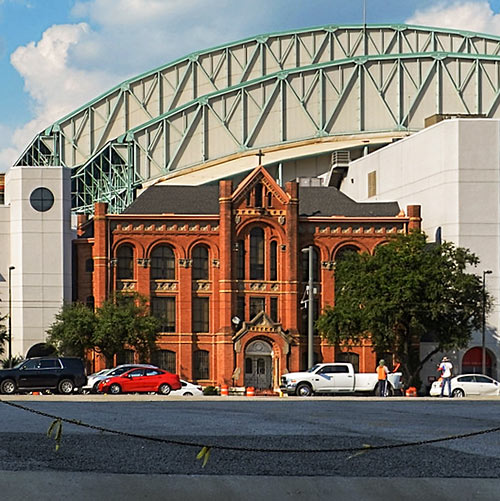COMMENT OF THE DAY: JUST A SUGGESTION FOR NAU  “There is a solution to this situation and it’s a little ironic.
The sisters of incarnate word want to stay downtown, but they say there’s no room.
John Nau and his group own the block right next door to the campus. They just announced that they were canceling their fund raising efforts and giving all of the money donated back to the donors for a Houston history museum.
It seems to me if John Nau wants to save some of Houston history, he could donate the block adjacent to the school so that that the historically important Nicholas Clayton building could be saved. That way his efforts to preserve history could still be accomplished, the nuns could stay downtown and the Nicholas Clayton building could be saved. Now that’s a lot easier than trying to figure out what to do with the dome!” [Bob R, commenting on Tearing Down Downtown’s Historic Incarnate Word Academy Building; A ‘Central Park’ for the Energy Corridor] Photo of Incarnate Word Academy, 600 Crawford St.: elnina
“There is a solution to this situation and it’s a little ironic.
The sisters of incarnate word want to stay downtown, but they say there’s no room.
John Nau and his group own the block right next door to the campus. They just announced that they were canceling their fund raising efforts and giving all of the money donated back to the donors for a Houston history museum.
It seems to me if John Nau wants to save some of Houston history, he could donate the block adjacent to the school so that that the historically important Nicholas Clayton building could be saved. That way his efforts to preserve history could still be accomplished, the nuns could stay downtown and the Nicholas Clayton building could be saved. Now that’s a lot easier than trying to figure out what to do with the dome!” [Bob R, commenting on Tearing Down Downtown’s Historic Incarnate Word Academy Building; A ‘Central Park’ for the Energy Corridor] Photo of Incarnate Word Academy, 600 Crawford St.: elnina





Why doesn’t the Nau center just build something for $30 Million? Why did it have to be $80 Million or nothing??
No need to donate. Just trade. Put the Nau center in where the school is and give the nuns the vacant lot in trade.
Houston does not save history. We have lost so many beautiful structures due to greed.
I agree with this comment, and Old School’s addition to it. What better place to put a Houston History museum, than in an Historic building? And I like CB’s comment, too. A $30 million renovation sounds like it could be workable on this building – granted I have no knowledge of the building’s specific needs and problems….
.
I do hope something can be worked out.
I don’t think the nuns tearing down a building because it’s too small for their school is greed….
an historic building is not a good place to create a museum unless you’re trying to build something with very little market appeal which is by no means the intent of the history museum. to retrofit the building they’d have to basically gut the entire thing and still end up with a expensive and inhospitable building. honestly, who would buy a functionally obsolete building potentially worth less than the land it’s on other than a government entity with money to waste? we certainly don’t have the funds for it and we obviously have much more important health and safety issues to find funding to combat before moving to such aspirational preservation goals.
A gut renovation would make sense. Whether it’s the nuns or the museum people who do it, they could keep the facade and essentially build a whole new building behind it. It’s not unheard of. Look at the Hearst Tower in Manhattan. They took a 40,000 square foot six story building from 1928, and turned it into an 860,000 square foot skyscraper.
.
The real issue is a disappointing lack of foresight and creativity on the part of the Nuns, and the museum people. Sadly not a unique thing here in Houaton.
It’s funny, a few years ago I lived in a city where pretty much the whole central city was built in the time period of this convent building. (Budapest, Hungary) You never heard of buildings suddenly needing to be torn down because a crack was discovered. It just didn’t happen. Life went on and the buildings went on.
.
Here in America, especially in Texas, people are always trying to justify tearing down an old building for this or that ticky-tack reason. Look what happened to another convent school building by the same architect, the Ursuline Academy in Galveston in 1961. Or his Ursuline Academy in Dallas. All buildings which would still be standing if they weren’t built in a state that had the cultural mentality of a 14-year-old, where newer and bigger is always better, and the past is just a mystifying irritation.
it really does go beyond just a simple mindset though. development costs throughout Europe are much higher than here in the states, and even more so in a low wage state like Texas. the feasibility formulas can be vastly different. although saving the outer facades and building within has been a huge hit throughout Europe with many examples, I’m not familiar with any of the retrofits occurring on smaller scale buildings such as this convents size.
***
Budapest is a large world heritage site and a global tourist destination with millions of visitors. the economic incentives for preservation tend to be very different amonst non-tourist cities. also helps to be a regional financial hub with lots of high-margin businesses that can afford to locate in older developments which come with higher costs due to less efficiencies.
***
not saying things couldn’t be better worked out for situations like this in Houston, but simply comparing a younger cities development and preservation standards against more established and aged cities doesn’t provide much insight into the feasibility of it all.
The Nau Center site is owned by the City of Houston. Not John Nau and not the Nau Center non-profit.
As much as I applaud the original comment in spirit, the reality of that happening is nil. A) as pointed out by lionowl, the land belongs to the city. B) the vision of the Nau center was modern, presenting history, yes, but in terms of modern, interactive, exhibits (really, what they had planned was cool. It was more visitor center than museum). It was never intended to be an artifact-based-old-school-museum. So, without a full gut-job, the Clayton building does not lend itself to the vision of the Nau project, even with a full gut job I think it would be hard to do.
All of that said, I don’t believe money was the only issue because as everyone has pointed out repeatedly, they could have scaled down the project in a multitude of ways. Somewhere along the line, someone in power decided this project was not wanted or that the location was too valuable to “waste” on a museum. I suspect the “pause” is permanent and would not be surprised if the Cohn house quietly disappears one night. Sad sad sad.
You are so right Bob! Of course the Nicolas Clayton building would make an excellent location for the Houston History Museum. Anyone know the architecture firm working for the Nuns helping them demolish this building?